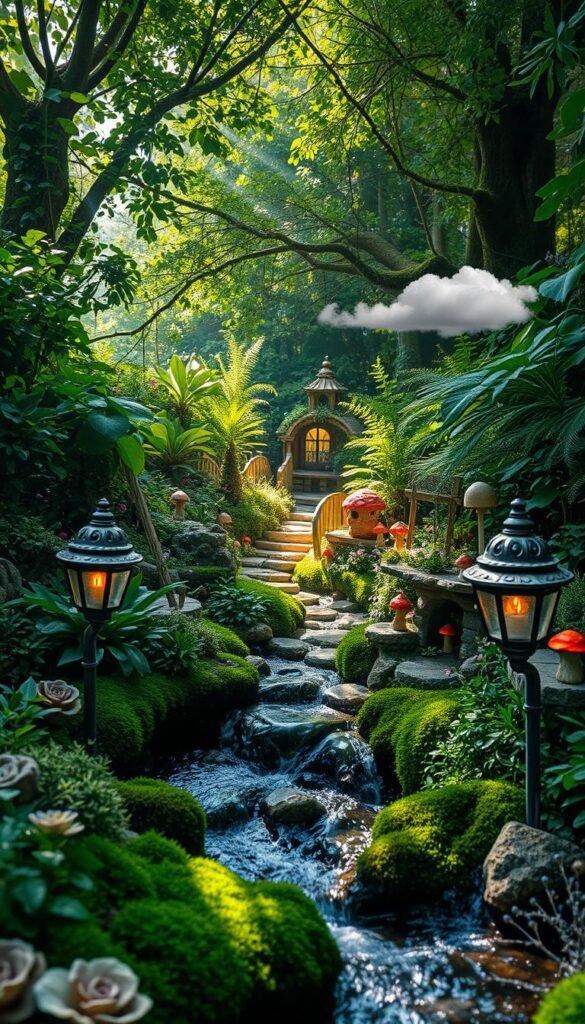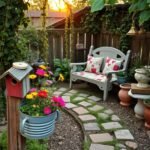Imagine transforming an ordinary corner of your yard into a whimsical escape where creativity blooms alongside tiny plants. These miniature landscapes blend nature and fantasy, offering a playful way to connect with your outdoor space. Whether you’re crafting with kids or seeking a relaxing hobby, this trend brings joy to every season.
Social media platforms like TikTok have sparked a surge in these enchanting projects. Thousands share their designs, proving you don’t need a large area to start. Even a single planter can become a lively habitat for imaginative storytelling.
These spaces do more than beautify your surroundings. They encourage mindfulness as you arrange tiny bridges, houses, and figurines. Families bond over choosing themes, while individuals find peace in nurturing their magical creations. Best of all, it’s adaptable—patios, balconies, or even windowsills work perfectly.
Ready to dive in? You’ll learn how simple materials like moss, pebbles, and thrifted items can build wonder. Let’s explore how this hobby mixes gardening with artistry, creating lasting memories one tiny detail at a time.
Understanding the Magic of Fairy Gardens
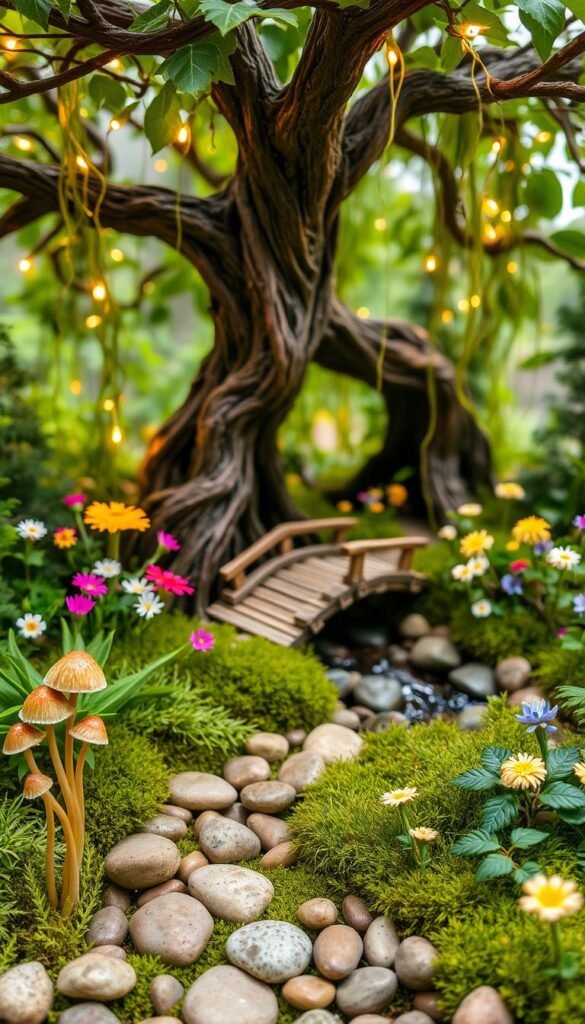
Picture a tiny universe where imagination grows alongside succulents and moss. These creative displays combine horticulture with storytelling, inviting you to craft spaces where whimsy meets nature. They’re not just decorations—they’re interactive worlds that evolve with your care.
What Are Fairy Gardens?
These miniature landscapes mirror real gardens but fit in containers or small nooks. As Janit Calvo, founder of The Mini Garden Guru, notes:
“They follow full-sized design rules—balance, texture, focal points—but work at 1:12 scale.”
You’ll find tiny benches, pebble paths, and evenfairy-sizedponds, all crafted toattract fairiesand spark joy.
| Full-Scale Gardens | Miniature Versions | Key Materials |
|---|---|---|
| Pathways | Crushed stone trails | Pea gravel |
| Shrubs | Dwarf plants | Polka dot plant |
| Accessories | Mini furniture | Upcycled items |
Inspiration Behind the Miniature World
Rose France (@roselynfrance) shares that many designs draw from children’s stories or folklore. Families often recreate scenes from Peter Pan or Frozen, blending play with gardening. This hobby bridges generations—adults nurture plants while kids arrange figurines.
Why does this trend thrive? It taps into our love for nurturing living art. A well-made setup can last a decade, offering endless chances to tweak layouts or add new characters. Plus, it’s a sneaky way to teach kids about ecosystems!
Planning Your Enchanted Outdoor Space
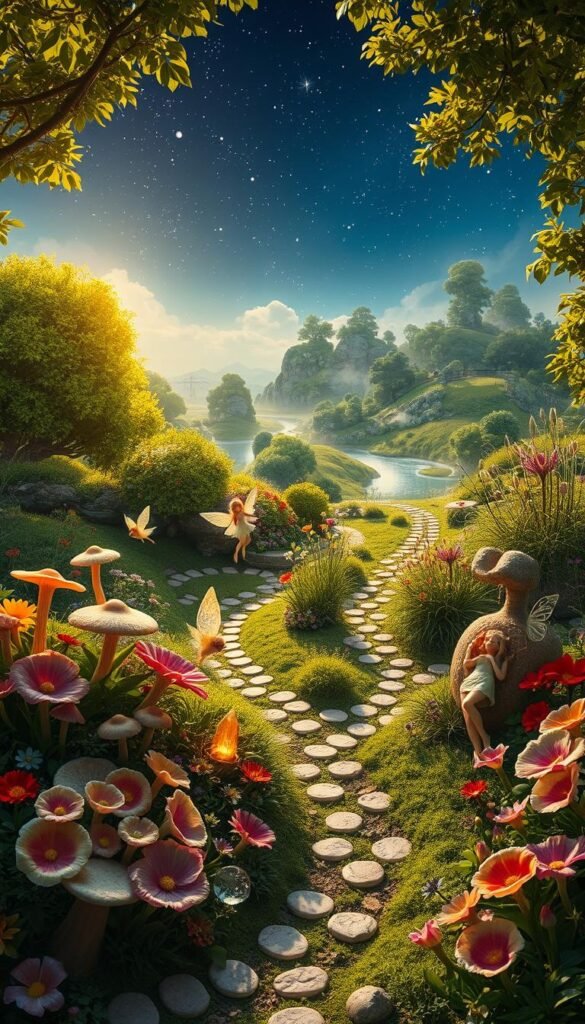
Finding the right location sets the stage for your miniature wonderland. Start by observing how sunlight moves across your yard throughout the day. Some plants thrive in morning sun but wilt in afternoon heat, while others need steady shade.
Choosing the Perfect Spot
Look for a flat area with good drainage to prevent water pooling. Julie Pruett suggests:
“Test different microclimates by placing saucers of water around your yard. Where it evaporates fastest often has ideal light and airflow.”
Prioritize spots visible from patios or windows so you can enjoy your creation daily. If space is limited, try vertical setups using stacked containers.
Budget-Friendly Materials and Supplies
TikTok creators like Rose France prove magical designs don’t need big spending. Check dollar stores for tiny tools and thrift shops for ceramic teacups that become ponds. Repurpose household items—corks as stools, jar lids as tables.
| Source | Best Finds | Cost Savings |
|---|---|---|
| Dollar Stores | Mini fences, pebbles | 80% less than craft stores |
| Thrift Shops | Broken jewelry, small dishes | Upcycled decor for $1-$3 |
| Home Recycling | Bottle caps, wine corks | 100% free |
Janit Calvo recommends investing in weather-resistant supplies like resin furniture. Pair these with affordable annual plants that refresh your garden each summer. Always leave room in your budget for spontaneous finds during shopping trips!
Outdoor Fairy Garden DIY: Building a Magical Scene in the Backyard

Creating a tiny world starts with smart plant choices and clever layouts. Match your greenery to the scale of your decorations for a believable environment. Janit Calvo advises:
“Treat containers like real plots—layer heights and textures just as you would in larger spaces.”
Plant Pairing for Perfect Proportions
Choose plants that stay under 6 inches tall. Dwarf varieties like creeping thyme work well as groundcover. Pair them with small flowers like mini petunias for pops of color. Moss makes excellent natural carpeting around fairy houses.
| Plant Type | Ideal Features | Top Picks |
|---|---|---|
| Groundcovers | Low-growing, spreads slowly | Irish moss, sedum |
| Accent Plants | Vertical interest, texture | Dwarf boxwood, mini ferns |
| Seasonal Stars | Colorful blooms | African violets, polka dot plant |
Crafting Homes from Nature’s Toolkit
Turn fallen branches into cozy cottages by stacking them log-cabin style. Use birch bark for roofs and pebbles for walkways. For vertical structures, attach twig ladders to containers. Small clay pots become charming chimneys when placed sideways.
Add personality with upcycled items—button signs or bottle-cap ponds. Let kids arrange miniature furniture made from wine corks or painted rocks. These touches make your creation feel lived-in while keeping costs low.
Crafting Your Whimsical Miniature Oasis
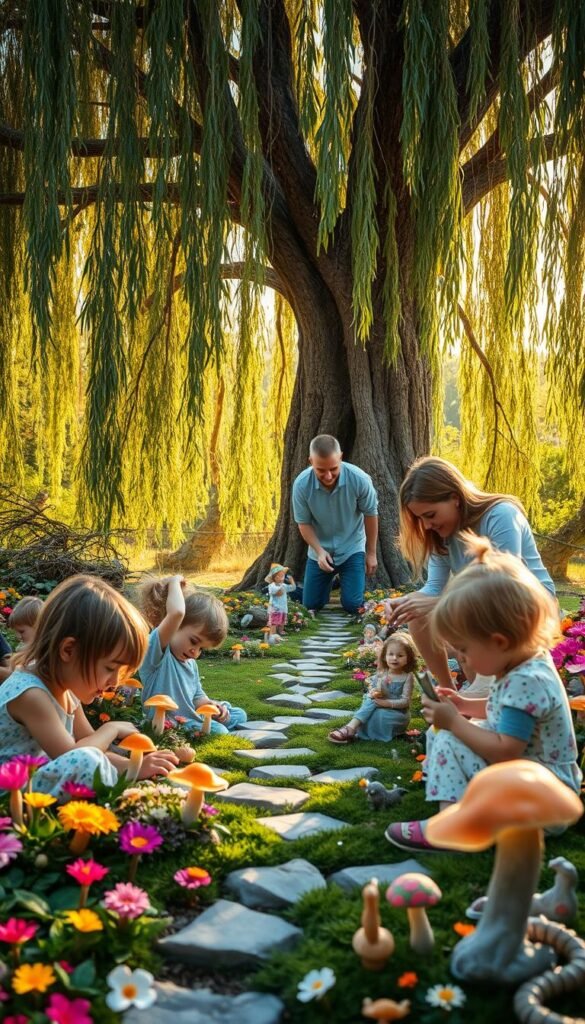
Bring generations together through tiny landscapes that spark creativity and connection. Ed Cooper, 69, shares his experience:
“Our fairy house projects let grandparents and grandkids collaborate equally—everyone leaves with muddy knees and big smiles.”
Family-Friendly Projects and Activities
Assign tasks based on age for maximum engagement. Little ones can collect pinecones for decor, while teens craft intricate pathways using pebbles. Even busy parents enjoy quick sessions arranging figurines or watering moss.
| Age Group | Suggested Tasks | Skill Development |
|---|---|---|
| 3-5 years | Leaf gathering, simple placements | Color recognition |
| 6-9 years | Path designing, naming characters | Spatial reasoning |
| 10+ years | Plant care, story writing | Responsibility |
Creative Reuse of Everyday Items
Transform household clutter into enchanting decor. Turn yogurt lids into shimmering ponds with blue paint and clear resin. Old keys become mystical gates when glued to popsicle sticks.
Try these upcycled ideas:
- Broken teacups → Whimsical seating areas
- Wine corks → Miniature tables
- Button collections → Colorful garden signs
These projects teach kids sustainability while stretching imaginations. Best part? You’ll create memories that last longer than any store-bought toy.
Incorporating Fairycore Aesthetics and Practical Gardening Tips
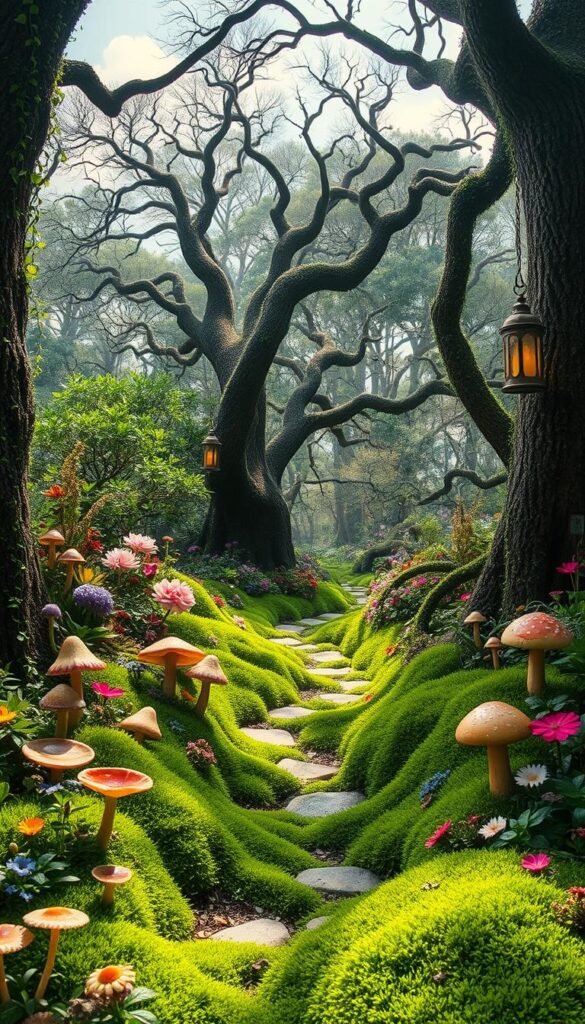
Blend earthy textures with playful details to craft spaces that feel both mystical and grounded. Mark Miller from Pittsburgh Botanic Garden suggests starting with smart layering: “Begin with pebbles for drainage, add activated charcoal to filter water, then build up with soil and moss.” This foundation keeps plants thriving while supporting your creative vision.
Embracing Natural Elements and Colors
Choose materials that whisper woodland charm. Twisted branches become arched doorways, while dried leaves mimic rustic rooftops. Stick to muted greens, browns, and soft blues to maintain that fairycore magic. These tones help tiny structures blend seamlessly with living moss and creeping thyme.
Balance beauty and plant health by matching decorations to your greenery’s needs. Shade-loving ferns pair well with mushroom figurines under tree canopies. Sunny spots bursting with sedum might feature miniature washing lines strung between twigs.
Enhancing Your Garden with Soft Lighting and Figurines
Solar-powered LEDs tucked under toadstools cast gentle glows at dusk. For rainy areas, waterproof battery lights inside resin cottages create cozy scenes. Position figurines near flower clusters or pebble paths to guide the eye without crowding plants.
Rotate accessories with the seasons—swap snow-dusted pines for summer butterflies. Always leave space for greenery to grow while protecting delicate pieces from harsh weather. With these tips, your enchanted space stays vibrant year-round.
Final Reflections on Your Fairy Garden Adventure
Your miniature world becomes more than decor—it’s a living storybook where family bonds grow alongside tiny plants. Liza Gardner Walsh reminds us that kids often surprise adults with fresh ideas, like crafting soup kitchens for hungry fairies instead of standard cottages. These evolving spaces adapt to your creativity, inviting new chapters with each season.
What began as a simple activity might blossom into cherished rituals. You’ll treasure moments spent arranging pebble paths or hunting for moss-covered stones. Over time, these shared efforts teach patience and nurture care for living things—skills that ripple beyond your garden.
Your creation serves as both art and sanctuary. Visitors might spot solar-lit toadstools or a repurposed teacup birdbath, proof that magic thrives in humble materials. As years pass, you’ll find joy in subtle changes—a creeping thyme carpet expanding or weathered figurines gaining character.
Ultimately, these tiny landscapes remind us to pause and wonder. They transform ordinary corners into spaces where imagination roots deeply, proving that the best memories often grow from small beginnings.

